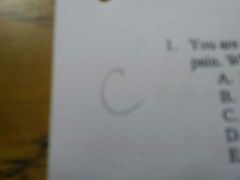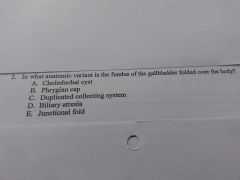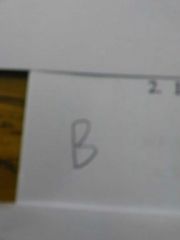![]()
![]()
![]()
Use LEFT and RIGHT arrow keys to navigate between flashcards;
Use UP and DOWN arrow keys to flip the card;
H to show hint;
A reads text to speech;
24 Cards in this Set
- Front
- Back

|

|
|

|

|
|
|
A patient is referred from the emergency room to rule out acute cholecystitis. You think the gallbladder wall may be thickened. What is the normal diameter of the gallbladder wall? A)<3mm B)<.5mm C)<35mm D)>3mm E)>3cm |
A)<3mm |
|
|
You are scanning the gallbladder and notice some smudgy echoes within it. You suspect the echoes are due to artifact. What is a common cause of artifactual echoes within the gallbladder? A)Reverberation B)Side lobes C)Slice thickness artifact D)A and B only E)All of the above |
E) All of the above |
|
|
You have a patient scheduled for a gallbladder sonogram. What preparation is required? A)There is no necessary preparation for a gallbladder sonogram B)The patient should drink 4-6 8 oz. glasses of water to improve hydration prior to the study. C)The patient should eat a fatty meal 30 minutes prior to the study. D)The patient should be fasting for 8-12 hours prior to the study. E)The patient should be fasting at least 24 hours prior to the study and ingest an anti-gas medication |
D)The patient should be fasting for 8-12 hours prior to the study |
|
|
You have been requested to preform a gallbladder ultrasound to rule out cholelithiasis. What is cholelithiasis? A)Gallbladder carcinoma B)Gallstones C)Gallbladder polyps D)Adenomyosis E)Gallbladder wall thickening |
B)Gallstones |
|
|
You are scanning the gallbladder and notice that the wall is abnormally thickened. Which of the following is NOT a cause of gallbladder wall thickening? A)Inflammation B)Hepatic dysfunction C)Congestive heart failure D)Malignant ascites E)Gallbladder wall varicies |
D)Malignant ascites |
|
|
A referring physician has asked you about the accuracy of gallbladder sonography. The diagnostic accuracy of gallbladder sonography is: A)>90% B)50% C)100% E)The diagnostic accuracy of gallbladder sonography cannot be determined. |
A)>90% |
|
|
During gallbladder sonography, you notice echogenic foci within the gallbladder but do not detect distal acoustic shadowing. What changes below will improve the detectability of stone shadowing? A)Increase transducer frequency, increase transducer focusing B)Decrease transducer frequency, increase gain C)Increase output power, decrease transducer frequency D)Increase dynamic range, increase gain E)Increase transducer focusing, decrease transducer frequency |
A)Increase transducer frequency, increase transducer focusing |
|
|
You are scanning a patient with a porcelain gallbladder. What does this term mean? A)The gallbladder wall is asymmetrically thickened B)The gallbladder is enlarged and tender C)The gallbladder wall contains varying amounts of calcification D)The gallbladder is enlarged and nontender E)The gallbladder contains multiple small cholesterol polyps |
C)The gallbladder wall contains varying amounts of calcification |
|
|
Which of the following best describes the location of the distal common bile duct? A)Anterior and superior to the pancreatic tail B)Medial and caudal to the pancreatic neck C)Posterior and slightly lateral to the pancreatic head D)inferior and medial to the pancreatic neck E)Posterior and medial to the pancreatic head |
C)Posterior and slightly lateral to the pancreatic head |
|
|
The patient you are scanning has eaten breakfast prior to your study. What is the appearance of the gallbladder in the postprandial state? A)Dilatation of a thin-walled gallbladder B)Contraction of the gallbladder with ditfuse wall thickening C)Nonvisibility of the gallbladder due to complete contraction D)Contraction of the gallbladder with asymmetric wall thickening E)Minimal contraction of the gallbladder with a sludge-filled lumen |
B)Contraction of the gallbladder with ditfuse wall thickening |
|
|
A patient presents to the ultrasound department for a sonogram to rule out biliary obstruction. Which lab test would best indicate the presence of bile duct obstruction? A)Serum creatinine B)Serum amylase C)Serum lipase D)Serum direct bilirubin E)Alphafetoprotein |
D)Serum direct bilirubin |
|
|
What is the most common cause of acute cholecystitis? A)Hepatitis B)Gallstone lodged in the fundus of the gallbladder C)Calculus obstruction of the gallbladder neck or cystic duct D)Pancreatitis E)Heaptocellular carcinoma |
C)Calculus obstruction of the gallbladder neck or cystic duct |
|
|
Tenderness over the gallbladder with probe pressure is termed: A)Murphy's sign B)Morrison's pouch C)Douglas's sign D)Tenderness of Trietz E)Courvoisier'a gallbladder |
A)Murphy's sign |
|
|
You are preforming an abdominal ultrasound study and detect a dilated, nontender gallbladder. What should you look for? A)Right kidney hydronephrosis B)Mass in the head of pancreas C)Mass in the posterior right lobe of the liver D)Abdominal aortic aneurysm E)Portal vein thrombosis |
B)Mass in the head of the pancreas |
|
|
Which of the following is a symptom associated with acute cholecystitis? A)Nausea B)Vomiting C)Epigastric pain D)Right upper quadrant pain E)All of the above |
E)All of the above |
|
|
You are preforming an ultrasound examination on a patient with acute cholecystitis. Complications of acute cholecystitis that you should look for include all of the following EXCEPT: A)Pancreatitis B)Pancreatic carcinoma C)Gallbladder perforation D)Gangrenous Cholecystitis E)Emphysematous cholecystitis |
B)Pancreatic carcinoma |
|
|
You have been asked to rule out the presence of choledocholithiasis. What are you looking for? A)Inflammation with thickening of gallbladder wall B)Stones within the common bile duct C)Calcified gallbladder wall D)Contracted gallbladder filled with stones E)Gallbladder carcinoma |
B)Stones within the common bile duct |
|
|
Identification of what anatomic structure would most help a sonographer locate a contracted gallbladder? A)Ligamentum teres B)Main lobar fissure C)Right hepatic vein D)Ligamentum venosum E)Coronary ligament |
B)Main lobar fissure |
|
|
The transverse diameter measurements of teh gallbladder in a fasting patient measure 5.3 cm. This measurement is: A)Within normal limits B)Consistent with a hydropic gallbladder C)Consistent with an abnormally contracted gallbladder D)Diagnostic of chronic cholecystitis E)Diagnostic of a Phrygian cap deformity of the gallbladder |
B)Consistent with a hydropic gallbladder |
|
|
You are scanning a patient in ICU and notice a low-level echoes within the gallbladder consistent with sludge. The gallbladder wall is not thickened. Which statement below is true? A)The patient most likely has acute acalculus cholecystitis B)These findings represent gallbladder preforation C)The patient had sludge most likely due to bile stasis D)The patient has a porcelain gallbladder E)The patient has pancreatic abnormality |
C)The patient has sludge most likely due to bile stasis |
|
|
Ultrasound images obtained on a 48 year old male show a comet tail or V shaped reverberation artifact originating from the anterior wall of the gallbladder. The artifact most likely result from: A)Adenomyomatosis B)Gallbladder carcinoma C)Side lobes D)Porcelain gallbladder E)Floating cholesterol stones |
A)Adenomyomatosis |
|
|
You are preforming an ultrasound study to rule out the presence of cholelithiasis. A small echogenic foci is seen in the posterior aspect of the gallbladder fundus. How can you determine if this foci represents a polyp or a stone? A)Shadowing is not present with polyps but is present with stones B)Unlike a stone, a polyp should move with varying patient positions C)A stone will produce a ringdown artifacts and no color Doppler signals D)An avascular mass with low-level echoes E)AN adherent, echogenic mass with weak color Doppler signals |
A)Shadowing is not present with polyps but is present with stones |

